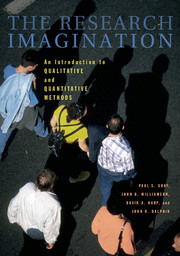Book contents
- Frontmatter
- Contents
- Preface
- 1 RESEARCH PROCESS
- 2 THEORY AND METHOD
- 3 RESEARCH DESIGN
- 4 MEASUREMENT
- 5 ETHICAL AND POLITICAL ISSUES
- 6 SAMPLING
- 7 SURVEY RESEARCH
- 8 INTENSIVE INTERVIEWING
- 9 OBSERVATIONAL FIELD RESEARCH
- 10 FEMINIST METHODS
- 11 HISTORICAL ANALYSIS
- 12 EXPERIMENTAL RESEARCH
- 13 CONTENT ANALYSIS
- 14 AGGREGATE DATA ANALYSIS
- 15 COMPARATIVE RESEARCH METHODS
- 16 EVALUATION RESEARCH
- 17 INDEXES AND SCALES
- 18 BASIC STATISTICAL ANALYSIS
- 19 MULTIVARIATE ANALYSIS AND STATISTICAL SIGNIFICANCE
- EPILOGUE: THE VALUE AND LIMITS OF SOCIAL SCIENCE KNOWLEDGE
- Appendix A A Precoded Questionnaire
- Appendix B Excerpt from a Codebook
- Author Index
- Subject Index
- References
3 - RESEARCH DESIGN
Published online by Cambridge University Press: 05 June 2012
- Frontmatter
- Contents
- Preface
- 1 RESEARCH PROCESS
- 2 THEORY AND METHOD
- 3 RESEARCH DESIGN
- 4 MEASUREMENT
- 5 ETHICAL AND POLITICAL ISSUES
- 6 SAMPLING
- 7 SURVEY RESEARCH
- 8 INTENSIVE INTERVIEWING
- 9 OBSERVATIONAL FIELD RESEARCH
- 10 FEMINIST METHODS
- 11 HISTORICAL ANALYSIS
- 12 EXPERIMENTAL RESEARCH
- 13 CONTENT ANALYSIS
- 14 AGGREGATE DATA ANALYSIS
- 15 COMPARATIVE RESEARCH METHODS
- 16 EVALUATION RESEARCH
- 17 INDEXES AND SCALES
- 18 BASIC STATISTICAL ANALYSIS
- 19 MULTIVARIATE ANALYSIS AND STATISTICAL SIGNIFICANCE
- EPILOGUE: THE VALUE AND LIMITS OF SOCIAL SCIENCE KNOWLEDGE
- Appendix A A Precoded Questionnaire
- Appendix B Excerpt from a Codebook
- Author Index
- Subject Index
- References
Summary
INTRODUCTION
The first two chapters have explained the elements of the scientific method and examined the connection between theory and the research process. After reading these chapters, you are now ready to look at how research is actually designed, step-by-step. research design is the overall process of using your imagination as well as the strategy and tactics of science to guide the collection and analysis of data. Have you have ever wondered: “What is a proper problem to write about in my term paper?” This issue, selecting a topic for study, is the first and most crucial one to be addressed in social research. The dilemmas of research design are sometimes difficult to resolve. Professional social scientists with years of experience sometimes wonder if investigating a problem that happens to interest them personally will produce a worthy addition to knowledge in their field of inquiry.
A related and equally thorny issue to be explored in this chapter is whether it is legitimate, or desirable, to be wholly descriptive in one's work, rather than explanatory. In other words, should all research make some theoretical contribution? In addition, we will examine the question of how much information is needed to substantiate an argument. The old axiom that “the more we know, the more we realize our own ignorance” certainly applies in social research. Are there guidelines to help us determine when we should stop collecting data and begin to analyze it?
- Type
- Chapter
- Information
- The Research ImaginationAn Introduction to Qualitative and Quantitative Methods, pp. 33 - 56Publisher: Cambridge University PressPrint publication year: 2007

